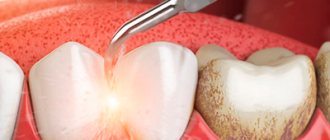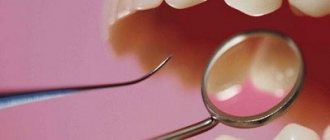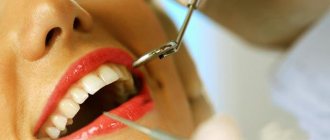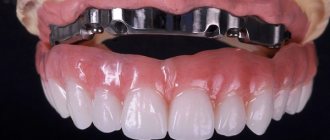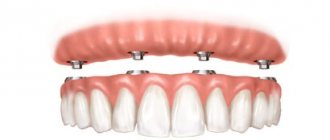From this article you will learn:
- how the procedure is performed (video),
- Air flow teeth cleaning – price 2021.
The article was written by a dentist with more than 19 years of experience.
Air flow teeth cleaning occurs by exposing the teeth to compressed air, water and fine particles of sodium bicarbonate. This method was developed by the Swiss company EMS (Electro medical system), and as we can see, it has much in common with sandblasting.
Indications for use –
- removal of pigment and bacterial plaque,
- removal of small hard dental deposits,
- polishing tooth enamel,
- polishing the surface of roots in periodontal pockets up to 5 mm deep.
Air Flow devices manufactured by EMS (Switzerland) and NSK (Japan) –
The devices can be made either in the form of a separate block (Fig. 1) or in the form of a special tip that is attached to the dental unit (Fig. 2-3). There is no big difference between devices from different manufacturers, but some doctors say that the flow of water-air spray with abrasive from NSK is somewhat softer.
In addition to the classic “Air Flow”, there is also the “Air-Flow Perio” system, which is designed for polishing the surface of the roots in deep periodontal pockets (more than 5 mm deep). Air-Flow Perio is a good alternative to the Vector device, which is also used in patients with periodontitis to remove subgingival plaque and polish the root surface.
Air Flow technology: key pros and cons of hardware sandblasting teeth cleaning
We are all familiar with the basic rules of oral hygiene: regular brushing of teeth twice every day, using dental floss, rinsing the mouth to remove food debris, systematically visiting the dentist's office for preventive examinations. But often this is not enough to provide reliable protection against caries and other dental pathologies. Professional teeth cleaning using the Air Flow system will help restore the natural whiteness of your smile and effectively remove dental plaque. Today we’ll talk in detail about what Air Flow cleaning is, how it’s done, what’s good about the technique and what its disadvantages are.
Air flow whitening –
Air flow teeth whitening – occurs by removing from the tooth surface absolutely all surface contaminants that can change the color of the tooth (bacterial and pigment plaque). However, you must understand that Air flow cannot change the natural color of the hard tissues of teeth - the latter can only be achieved through a chemical teeth whitening procedure.
Thus, Air flow whitening occurs only by removing external contaminants from the surface of the teeth - almost exactly the same as abrasive-type whitening toothpastes do. It is only natural that such pastes will be much less effective than professional cleaning or chemical bleaching.
Air Flow - what is the essence of technology
The technology involves the use of a special Swiss-made Air Flow sandblasting machine. As part of the procedure, the enamel is treated with a special solution, which is supplied in the form of a jet under high pressure. The composition includes sodium bicarbonate mixed with oxygen. It is important to note that the solution does not damage the upper protective layer of the teeth.
So, the device itself provides two independent channels: the first provides the supply of abrasive powder mixed with water, while the second transmits a powerful air flow. Bacteria and tiny food debris literally peel off from the enamel. The doctor carefully treats each tooth, carefully removing pathogens even from the most inaccessible places, including periodontal pockets.
The products used during the procedure are also produced in Switzerland by EMS. Currently, formulations are available on the market, both neutral, that is, without any fragrances, and with various aromas. The first option is ideal for those patients who are prone to allergic reactions. In total, there are three variants of mixtures with different bases: classic, PERIO, SOFT1.
How painful is the procedure?
Comprehensive cleaning using the Air Flow system is carried out in the most comfortable environment for the patient. During the processing of enamel, some unpleasant sensations may occur, but no significant pain. To ensure the outflow of the sprayed product, a special suction is used, which, however, cannot guarantee 100% protection against contact of the composition with the mucous membrane of the mouth and pharynx. As a result, the patient may experience a slight burning sensation and dry soft tissues after the procedure. If you swallow too much of the cleanser, it can cause heartburn and indigestion.
Air Flow: price 2021
The price range for this service is very wide. Much will depend on the equipment: the cost of a service using an original EMS device will be an order of magnitude higher than working with an NSK AirFlow handpiece. Accordingly, this will greatly affect the final cost of the service.
In addition, the price depends on whether you need to do only Air flow, or whether you need a comprehensive cleaning, which will also include ultrasonic cleaning + fluoridation of teeth after the procedure. Such a comprehensive cleaning in the regions will cost starting from 2500 rubles, in Moscow - from 3500-4000 rubles (in economy class clinics).
If you only need to do Air Flow, the price in different Moscow clinics ranges from 2,500 thousand to 5,000 rubles.
When is Air Flow cleaning indicated?
Air-Flow hygienic cleaning is an independent manipulation that is used to thoroughly remove plaque and soft dental deposits in order to avoid the development of carious and inflammatory processes. This is also a prerequisite for preparation for dental implantation, installation of crowns and dentures, and whitening using professional methods.
Thus, among the main indications for the use of Air-Flow technology, experts in the field of dentistry and hygiene identify the following phenomena and conditions:
- the formation of a dense layer of plaque on the teeth,
- change in enamel color,
- crowding of teeth, in which other methods of cleaning interdental spaces will be ineffective,
- recent completion of a course of orthodontic treatment using braces,
- upcoming professional whitening, implantation or prosthetics.
Plaque on teeth is an indication for using the method.
Experts say that this procedure should be done twice a year - the optimal frequency for maintaining the proper level of oral hygiene. Cleaning is especially recommended for smokers and coffee lovers.
Indications and contraindications
Indications:
- Prevention of caries
- Before dentures with crowns or implants (for correct selection of denture color)
- Before installing braces
- Before performing ZOOM-4 whitening (to obtain a uniform effect)
- When symptoms of periodontal disease appear
- The need to clean the braces system
- Pigmentation of enamel with natural or artificial dyes
- Excessively crowded arrangement of elements in the dentition
Contraindications:
- Allergy to baking soda
- Children's age (up to 10 years)
- Diseases of the ENT organs accompanied by nasal congestion
- Bronchial asthma
- Chronical bronchitis
- Inflammation of gingival tissue in acute form
What are the restrictions?
The technique is absolutely safe for the health of teeth and the oral cavity in general, however, it still has certain contraindications for use. Thus, Air-Flow hardware cleaning is not prescribed in the following situations:
- periodontal disease - there is a risk of bleeding, as well as gum inflammation and swelling,
- impressive volumes of dental plaque – unfortunately, the device cannot cope with deep and long-hardened dental plaque. Here it is better to resort to ultrasonic enamel cleaning techniques,
Ultrasound removal of tartar - pathological conditions of the respiratory system,
- allergy to citrus.
Also, this procedure does not apply to patients who, for health reasons, must adhere to a salt-free diet. Such cleaning is allowed for pregnant women and nursing mothers, but it should be carried out with extreme caution.
Contraindications to the procedure
The method is safe for health, but still has some contraindications:
- asthma, bronchitis and other respiratory diseases (due to the threat of an attack of suffocation);
- inflammatory periodontal diseases in the acute stage;
- thinned, weak enamel, as well as its increased sensitivity to temperature and mechanical stimuli;
- bruxism, which is characterized by pathological wear of teeth;
- deep carious lesions;
- childhood.
Strengths and weaknesses of sandblasting
The Air-Flow method is characterized by a whole list of undeniable advantages over other enamel cleansing technologies, including ultrasound. Thus, among the main advantages, experts and patients highlight the following points:
- absence of pain and severe discomfort,
- lack of direct contact with the device, which in other cases significantly increases the risk of damage to the enamel,
- the ability to process hard-to-reach places,
- noticeable results immediately after the session,
- the absence of toxic and harmful components in the composition of the product used,
- additional enrichment of enamel with fluoride.
The photo shows teeth before and after the procedure
“But the Air-flow system worked fine for me, I didn’t feel any pain at all. It was much more unpleasant when plaque and stone were removed manually, as before. The procedure was prescribed immediately after the braces were removed, but my teeth became white, as if they had been bleached. True, on the day of the procedure the sensitivity of the enamel increased, but the next day everything went away. Don't be afraid, it's not like pulling out a tooth. They just spray it with water and a pressure cleaner and that’s it...”
Marisha89, Omsk, from correspondence on the woman.ru forum
One of the disadvantages is the fact that as a result of such hardware cleaning, the enamel becomes naturally white, but not snow-white, as in the case of bleaching. Plaque and pigmentation are removed, but the natural shade of the teeth is not changed. In addition, if the device is handled carelessly, there is a risk of minor injury to the mucous membrane. Otherwise, this is a truly safe and effective method of preventing dental diseases.
Advantages and disadvantages of the method
The advantages of professional hardware cleaning are multifaceted:
- thorough hygienic treatment of prosthetic and orthodontic systems (crowns, bridges, braces, etc.);
- the ability to clean not only the supragingival part of the tooth, but also the subgingival part (up to 5 mm);
- efficiency of execution (about 30 minutes);
- absence of discomfort and pain;
- elimination of pigmented areas;
- slight lightening of the enamel shade (by 1 – 2 tones);
- eliminating unpleasant odors caused by plaque accumulation.
This method has one drawback - the inability to clean tartar deposits. Its density is so high that the force of a directed jet of water mixture is not enough to crush it.
Air flow technology - description of the procedure
An enamel cleansing session usually takes no more than half an hour. The top plaque formed under the influence of food and drinks, especially those containing coloring pigments, is removed. It should be noted right away that the technique does not refer to a method of artificially lightening enamel, which means that the procedure allows you to achieve natural whiteness of teeth. If your natural enamel shade is slightly yellowish or grayish, you should not count on a snow-white Hollywood smile. To make the natural color flawlessly white, you will have to undergo a professional lightening procedure or resort to the help of veneers.
Preparatory activities
First, you will have to undergo a standard oral examination by a dentist. The specialist will assess the extent of the problem and offer the best option for removing supra- and subgingival deposits. If you are prone to allergic reactions or suffer from intolerance to the components of the products used, be sure to inform your doctor. It is better for women not to use cosmetics before the session, as washing may be required after the procedure.
Before the procedure, you need to undergo an examination by a dentist
Description of the enamel cleansing session
The process of cleaning enamel using the Air Flow device involves several stages. Below is a brief step-by-step description of the procedure:
- first, the doctor covers the patient’s lips with Vaseline so that they do not dry out,
- after this, a saliva ejector is placed in the mouth, which helps to avoid excessive salivation during the procedure,
- then a special hat and glasses are put on to protect the face and hair from small particles of abrasive powder for brushing teeth,
- the doctor carefully treats each tooth, making sure that the jet does not fall on soft tissues and dentin in the presence of caries and erosions,
- the treated enamel is coated with a special fluorine-containing composition, which ensures that the achieved effect is consolidated.
The photo shows the procedure for brushing teeth with the Air Flow system.
The dentist independently controls the force of the jet pressure, thus optimizing the intensity of its effect on soft and hard deposits. As a result, effective, but at the same time gentle removal of plaque and food debris occurs, which serves as the best prevention of caries.
Recovery stage
Immediately after the session, the teeth lose their thin surface film, so for some time the enamel may react sharply to mechanical stress and sudden temperature changes - a completely natural phenomenon that does not need to be alarmed. To preserve the achieved effect, experts recommend not smoking, drinking caffeine-containing drinks, black tea and colored soda for 2-3 hours. It is also worth at least temporarily limiting the consumption of fruits and berries that contain intense coloring pigments.
Who is this procedure indicated for?
- Sandblasting is recommended for people who have plaque or tartar. It is also part of preventive procedures aimed at preventing the occurrence of dental caries.
- Sandblasting teeth cleaning is recommended for people who wear orthodontic appliances, as well as people with malocclusions.
- This type of cleaning is recommended for all people who want to lighten their teeth several shades. This method is especially suitable for people who smoke or drink a lot of coffee or strong tea.
Sandblasting is safe and painless and may only cause minor and short-term gum irritation and a salty taste in the mouth. The procedure will not damage the enamel.
Recommendations after treatment
The protective film on the enamel is restored in just a couple of hours, but until this happens, the patient needs to adhere to some simple rules. This is the only way the result will last as long as possible. Recommendations after brushing your teeth to remove tartar include giving up cigarettes and coffee for at least 2-3 hours. In the first couple of days, it is better to refrain from consuming the following drinks and foods:
- coffee drinks, juices with natural and artificial colors, red wine, strong black tea, colored sodas,
- berries, mustard and soy sauce, beets and other coloring foods.
After the procedure, it is advisable to stop drinking coffee.
As noted above, in the first couple of days the patient may experience increased sensitivity of the enamel, especially in relation to excessively hot and cold foods and drinks. The condition of dental tissues is normalized literally within 1-2 days.
What can you eat after a professional teeth reading?
You can start eating almost immediately after professional cleaning. But doctors still advise waiting at least 1 hour.
If fluoridation of the dental surface has been carried out, then it is necessary to abstain from food for at least 2 hours.
Anything that does not contain food or natural dyes is allowed to be used in food. Dentists especially recommend eating more solid foods - fruits and vegetables, such as apples, as they reduce the risk of plaque forming on the surface of the teeth.
It is recommended to increase the amount of calcium-rich foods in your diet - milk, cottage cheese, kefir. But after using soft food, it is imperative to brush your teeth, rinse your mouth and use dental floss, since such food will actively clog into hard-to-reach places.
Also, to maintain the effect of brushing your teeth in the first days, it is recommended to drink mainly water, very lightly brewed tea or apple juice, but diluted with water.
